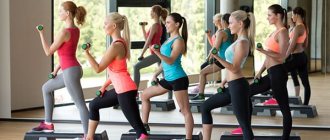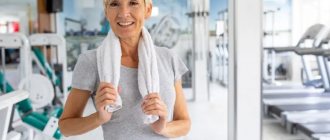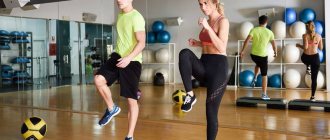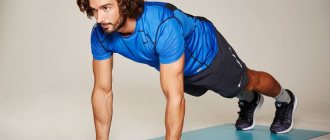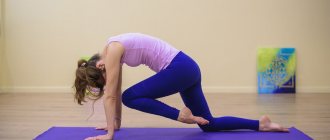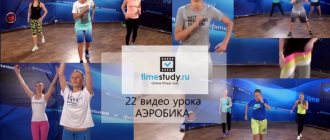Fitness is a health system aimed at maintaining and improving physical performance, body shaping, and weight normalization. In order for fitness classes to bring the desired effect to beginners, you should familiarize yourself with a number of recommendations and tips. This will allow you to avoid common mistakes and achieve improved physical fitness without any harm to your health.
Purpose of fitness classes
It is much more convenient to engage in fitness by working on specific parameters. It is much easier to set a goal to learn how to do 30 push-ups per set than to pursue a goal - to improve your health or something even more abstract.
Therefore, to begin with, formulate at least some goal for your studies. For example:
– run 5 km without stopping
– bench press a 60 kg barbell 10 times per approach
- do 15 pull-ups without stopping
Etc. Please note that it is highly advisable to choose a goal so that it depends only on fitness activities and your discipline.
If your goal is to lose extra pounds, then you risk not getting what you want, even if you try very hard in training. After all, this goal depends not only on training, but also on diet, hormonal status and much more.
However, achieving results in specific exercises almost always leads to significant improvements in various body parameters. Including weights.
Preparation
When you are sure that your health allows you to give your body physical activity, you can start working out in the gym. But here, too, it is necessary to follow the basic rules:
- After eating, at least an hour must pass before starting intensive exercise;
- It is better to train in sneakers - exercising in socks or barefoot may be unsafe;
- Each workout should begin with a warm-up and stretching;
- drink water in doses during training;
- you need to start with exercises that do not load the axial skeleton: rowing and exercise bikes, swimming, elliptical and cardio exercises without jumping.
Don't overwork yourself. The first workouts are first until you are slightly tired, then until you are moderately tired. In the gym, choose your weight carefully. Under no circumstances should you attempt to work through pain. If any exercise causes acute discomfort, it should be completely abandoned. Evgeniy Grapov
A person who is obese, but is determined to work out in the gym, at first needs to go on a diet prescribed by qualified doctors, and do only cardio training without heavy loads.
Study space
Whatever one may say, you need to do fitness in a certain place. Decide where it is more convenient for you to train: at home, in the gym or on the street. Maybe somewhere else. Just put a tick in your head that you will spend the next 10-20 workouts here, in the chosen location. This greatly simplifies everything else. You won't have to think about where to do your workout every time you remember about it.
When choosing, keep in mind that you will have to get to the fitness club and spend quite a lot of time on it. And training at home requires a certain restructuring of home habits, the acquisition of simple equipment and the organization of a place for training.
For whom fitness is contraindicated
A lot has been said about the benefits of fitness, but there are situations when such physical activity is not recommended and can even be harmful. We are talking about people for whom fitness is contraindicated for medical reasons. There are diseases for which fitness of any kind is not permitted:
- mental disorders, epilepsy;
- severe lesions and heart disease;
- oncology;
- chronic liver and kidney diseases;
- respiratory system diseases;
- diabetes;
- severe traumatic brain injuries and spinal injuries.
A doctor may temporarily prohibit visiting the gym after suffering an infectious or inflammatory disease or with a weakened immune system. In other cases, there may be contraindications associated with certain types of fitness.
Doctor and medical examination
Be sure to consult your doctor before starting exercise. Ideally, with a sports doctor. Many fitness clubs now have a doctor on staff for initial medical examinations and testing. This is very correct!
The doctor must check blood pressure, vision, posture, pulse, and conduct other necessary tests.
You should visit the doctor regularly, and not once, in order to notice certain negative changes in time, which are difficult for an unqualified person to notice.
Body check. What is important to do before you start training?
Trainer
A coach is a very useful creature when you need to understand the many nuances and subtleties of training. Try to consult with an experienced trainer at least once in order to eliminate possible wrong steps and mistakes in advance. Ideally, you should constantly exercise under the guidance or supervision of a trainer. It's always more reliable this way. And there is always someone to ask questions. A trainer usually costs extra money. But this is almost always justified.
It is important to learn to distinguish a trainer from a regular gym instructor. A coach is a much more qualified and educated specialist. His task is to create training programs for you, conduct tests, monitor results and certain health parameters. And the trainer will never wander around the gym idle or insure random gym visitors in the bench press. He has enough other worries too. For example, to finish a doctoral dissertation in sports medicine...
The instructor can only teach you how to use the exercise equipment and makes sure that you are not crushed by the barbell. Maximum - can give a standard program recommended by a fitness club. Of course, this program may not be suitable for you at all. And almost any more or less handsome, pumped-up guy is usually hired as an instructor. The coach can easily turn out to be a grumpy fat guy. But with really pumped up brains and skills. And he is the one who can know much better what you should do so that everything goes as it should.
Initial testing
This is a simple test of your initial physical capabilities and abilities. And also checking strength, endurance, speed, posture, flexibility, joint condition, reflexes, body girth, weight, height, pulse, etc.
This is necessary so that after each month of training you can check them again and notice the difference. It is these measurements that will tell the coach how the complex worked and how hard you tried. So don’t even think about slacking on your workouts! You can't fool the tests! They are objective. That’s why they are needed to see not what you think, but what actually is.
Examples of fitness tests:
Cooper tests Flexibility tests Ruffier-Dixon test
Training program
This is the set of exercises and techniques that you use in your classes. Training programs are also called exercise sets. It is the same.
Typically, a set of exercises includes about a dozen exercises and the rules for their implementation: the number of approaches and repetitions, working weight, tempo of execution, instructions for equipment, etc. The training methods that apply to this complex must be separately prescribed. For example, circuit training or cluster sets.
A set of exercises is performed several times a week or every day. It depends on the specific training direction and goals. For example, sets of flexibility exercises are done every day. And the program for gaining strength and muscle mass - two to three times a week.
To properly engage in fitness, you need the right complex. You can, of course, take the first complex you like from the Internet or a glossy magazine. But this complex may turn out to be completely inappropriate, far from your reality. And if you use it too zealously, injury and overtraining can occur. Or you will pump yourself into something wrong. Yes, this happens too!

